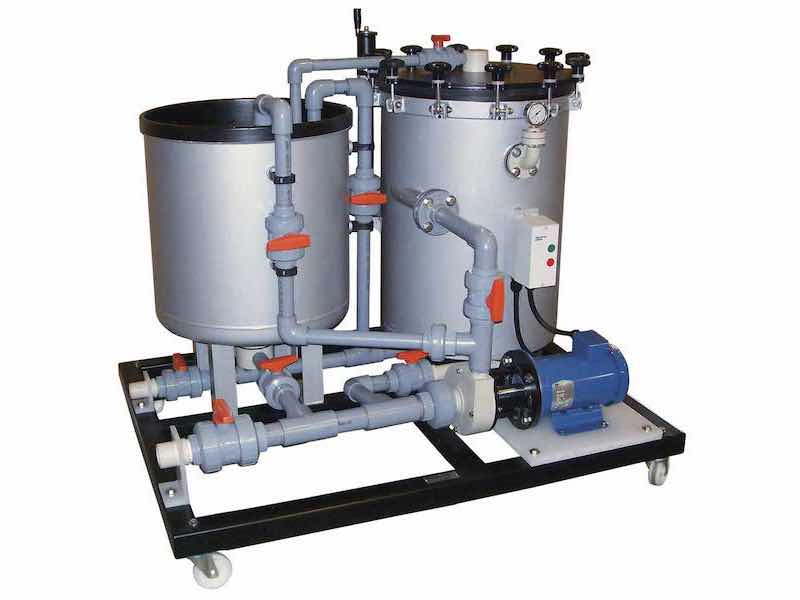As a means of treatment, the procedure of filtration encompasses many consumer and commercial applications.
 Stephen F. Rudy CEFPurification, or focusing on remediation in returning to standard operation, can be achieved by proper filtration.
Stephen F. Rudy CEFPurification, or focusing on remediation in returning to standard operation, can be achieved by proper filtration.
The food and beverage industry would be hard pressed without the ability to blend and mix ingredients, resulting in tasteful, nutritious products. In our homes we may fill canisters with filtered water, insert coffee into the filter paper and await some fresh brewed java. Before baking a cake or dessert, the mixture may have been passed through a cheese cloth. Various industries also employ filtration in many specific disciplines, as does the medical field. Because of its ability to enhance mixing and first rate purification effectiveness, much of what is now done on a daily basis would not be possible. This especially includes metal finishing. Filtration as a means of purification is critical to optimum performance of finishing processes.
Plating solutions typically undergo continuous or periodic filtrations. In the baths, organic additives undergo breakdown into moieties that may co-deposit with metals, forming inter metallic complexes that affect desired deposit characteristics. These include poor ductility, adhesion failure, pitting, blistering, rapid passivity of the coating (inactive to an intended top coat), among the common problems. Contaminants are also introduced into these baths from preceding treatments or steps. Insufficient or poor rinsing, drag in of solutions, poor cleaning, are some common problems in this regard. On a gradual basis, typically minute quantities of contaminated rinse waters are dragged in. While plating, some organic additives may be oxidized, sludge can build up due to side chemical reactions which occur. Left unchecked, these and other contamination sources described can accumulate to the point that preferred metal deposition is detrimentally affected. Or worse, the bath or process may be shut down having to initiate appropriate corrections actions and treatments. In addition, specifications may not be met, corrosion resistance of the finish may be compromised and rejects become an expensive reality. To offset these and other problems, finishers have successfully used carbon as a filtering medium, removing many of the organic, water soluble or emulsified contaminants. An effective filtration system incorporates the following progression:
Pump plating solution from tank through a filter chamber → Continue through a carbon chamber → Return to the plating tank.
Carbon Excellent for Contanimants
This has proven to be most effective, especially since carbon is an excellent medium for removal of specific contaminants. Over the years, hard-to-handle powdered carbon has been supplanted by granular material, in most filtration applications. This does not dispel the fact that powdered carbon provides a tremendous surface to volume ration, for effective purification. The filtration system may employ carbon-filled cartridges for baths up to a few hundred gallons. Larger precoated, enclosed disk units are more effective on baths approaching 1,000 gallons and above.
An optimum type of granular, activated carbon to use for most plating bath filtration and purification purposes, consists of +10 mesh, 5% maximum and -40 mesh, 0.5% maximum.
The total surface area of the material is to be in a range of 1,000 to 1,100 square meter / gram.
Precoat media can also be used when coating plates or disks with carbon. Diatomaceous earth is recommended for such common plating solutions as nickel, acid copper, acid tin and acid zinc. Alpha cellulose is recommended for the alkaline and cyanide plating baths.
High Flow Maximizes Soil Holding Capacity
It has been found that high solution flow rates, using coarse or granular carbon, actually maximize the soil holding capacity. This is because a small amount of fine particles is retained in the media. Upon each subsequent pass of solution, more of the fine particles are held, forming a precoat that actually seals the coarse surface, increasing the capacity to remove and hold fine particles.
Carbon cartridges are a convenient and clean system to maintain adequate solution purification. The cartridges are commercially available in lengths from 10 to 30 inches, fitting most filter chambers. Carbon is prepacked with a binder, and the cylinder sealed. Maintenance consists of simply replacing the used cartridge with a fresh one. There is no mess or personal handling of carbon.
Ready-to-use canisters are filled and sealed with from 5 to over 10 lb. of granular carbon. The canister is placed in the filtration line preceded by a filter chamber, which removes fine particles. The soiled or loaded canister is replaced with a fresh one.
Precoating the larger disk units consists of co-depositing the previously described filter aid material with powdered carbon on to a membrane. The typical procedure is to coat the membrane from a slurry of diatomaceous earth followed by a coat of carbon, then complete with another coat of diatomaceous earth. The diatomaceous earth helps by sealing in the powdered carbon. The loading is one part of carbon to two parts diatomaceous earth. Equipment manufacturers will specify the appropriate weights of carbon and diatomaceous earth for their particular units.
Batch Purification
Batch purification is a more aggressive treatment for the plating bath. The procedure must be conducted by transferring the plating solution to a treatment tank. Depending on the type of bath or degree of contamination, oxidizing agents such as hydrogen peroxide or potassium permanganate may be used in conjunction with the carbon. The amount of carbon used in this treatment may be in the range of 13 to 40 oz/100 gal.
Employing the proper filtration improves efficiency of the process. This is very critical in that many plating installations minimize drag out losses, recycling plating solution back to the process tank. Purification filtration becomes more critical to remove organic and particle contaminants. This is why equipment improvements allow for excellent service life of filtering units and their inherent parts. Carbon and related media are supplied in convenient packaging for ease of installation, maintenance and replacement. Because of the dependable utility of equipment, one or two bath turnovers can be improved to two to four. More solution filtration over time improves clarity, plating quality and overall process performance. A superior filtration system with carbon would use a system rated to turnover the solution from two to ten times per hour. At the discharge point, 80 to 95% of the filtered solution returns to the plating tank, while 5 to 20% flows to a granular carbon bed, passes through, and back to the plating tank.
Contaminants are Preventable
It is critical to note sources of contaminants in the plating bath that are preventable. For example, oils and grease dragged in would indicate poor cleaning and/or insufficient rinsing. Ripped anode bags are a continual source of plating deposit roughness. In the example of nickel plating, the process is 93% efficient, while closed looping may be up to 100% efficient. This unfortunate circumstance builds contaminants and also promotes a common ion effect, where precipitated salts coat the anodes, resulting in polarization. Parts dropped in the plating tank, depending on solution pH, may gradually dissolve, resulting in metallic contamination. These are problems that filtration is not a cure all for. There is no magic wand. But by practicing good maintenance, optimizing processes and staying the course, proper filtration adds that extra octane, supplying high performance to metal finishing processes.
Stephen F. Rudy, CEF, is president of Chem Analytic and has written extensively about the finishing industry. Visit www.chemanalytic.com or call him at 917-604-5001.



































